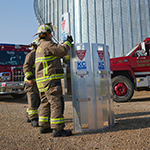Rodent control for food processing facilities
Follow these suggestions to control rodents in your food processing facility.
Each year, commensal rodents (rats and mice) cause significant damage to the world’s food supply. It is estimated they are responsible for destroying 20 percent of the world’s crop production annually.
In the U.S., the Norway rat, roof rat and house mouse pose a considerable threat to the food and feed industries.
Rodents also carry diseases, which can be transmitted to people — posing a serious health risk to the general public and a significant economic risk to the food processor. For example, the deer mouse can carry hantaviruses, which can cause a rare but deadly disease called hantavirus pulmonary syndrome.
As part of your overall integrated pest management program, a written rodent control program is essential to protecting food, pet food, feed and commodity grain processors from the unintentional contamination or destruction of product.
The following components should help in controlling or eliminating rodents in and around your facility.
Rodents of concern
The house mouse
The house mouse is extremely adaptable to surviving adverse conditions and can be found in many areas of a food or feed facility. The house mouse, which is most active at night, needs little food and even less water to survive. A mouse is often able to obtain enough water from the foods it eats.
The house mouse typically lives between 6-18 months and on average produces 6 young per litter 8 times per year. The house mouse will eat most human foods, but prefers meats, grains, cereals, seeds, fruits and vegetables. Mice commonly nest near food, but may forage 30 feet or more from a food source and may feed 20-30 times per day. A mouse produces 50-75 droppings per day and leaves odor trails of urine, hair and pheromone laden dust (allergenic.)
The Norway rat
The Norway rat is a common urban and rural rat found throughout the U.S. It is the largest of commensal rats and is primarily nocturnal. It can be identified by its stocky body, small ears and a tail shorter than its head and body. The Norway rat burrows extensively and eats primarily cereal and other grains. Because it is omnivorous, the rat will eat household garbage.
The Norway rat lives between 6 to 18 months and produces 8-12 pups per litter 3-7 times per year. Unlike the house mouse, it requires water to survive. The rat is a fair climber and an excellent swimmer. It typically ranges 50-150 feet from its nests, but may forage 400 feet for food. It will generate 40-50 droppings per day and leave odor trails of urine, hair, scales, dander, partially consumed food and pheromone laden dust (allergenic.)
The roof rat
The roof rat, commonly called the ship rat or black rat, lives worldwide and is abundant in ports and contiguous areas, especially coastal areas of the U.S. It is smaller than the Norway rat and is primarily nocturnal. It can be identified by its slender, long-pointed muzzle and a tail longer than its head and body combined. The roof rat tends to live above ground and burrows infrequently.
The roof rat lives approximately 18 months and will produce 6-14 pups per litter 3-7 times per year. It also requires water and eats fruit, nuts, grains and invertebrates (snails and insects), but is omnivorous. It is an excellent climber and usually enters and nests in upper parts of buildings and also outdoors in trees (especially palms) and ivy. It may forage 400 feet for food. The roof rat will generate 40-50 droppings per day and leaves odor trails of urine, hair, scales, dander, partially consumed food and pheromone laden dust (allergenic.)
How to spot a rodent
- Droppings — If there are rodent issues, you will find droppings. Be sure to accurately identify the droppings and not confuse them for cockroach or bat droppings. Rodent droppings will contain hairs, as rodents are continually grooming themselves. There are numerous images on the Internet to assist you.
- Tracks — Rodent footprints can be easily identified in dusty areas.
- Gnawing damage — Rodents will gnaw on many materials such as boxes, insulation, wiring and other construction materials.
- Burrows — Search for burrows around the facility. Burrows should be baited with pellet baits and not collapsed for several days until evidence of a dead rodent is noted.
- Runways, grease marks and urine stains — Rodents prefer to travel along and in contact with vertical surfaces rather than in the open. They are wary of crossing open spaces that provide no cover. In doing so, they form runs that can be identified by grease marks. The presence of rodents can also be identified with the use of a black light. Rodent urine will fluoresce under a black light. Many companies use black lights to assist in inspecting incoming pallets and goods of materials for rodent activity. If rodent urine is suspected, look for other signs, such as hairs, droppings or gnawing damage as other materials such as starches in glue will also fluoresce under a black light.
- Rodent odors — The presence of rodents in larger numbers is often detected by a strong odor in areas where they nest or forage for food and nesting materials.
The first line the defense is outside of the facility
The first line of defense in rodent control is the maintaining of grounds around buildings.
Avoid planting bushes and shrubbery next to buildings and do not plant ground crawling plants such as evergreen and juniper bushes or vegetation that produces fruits or nuts to eliminate a food source for rodents.
In grassy areas and fields, keep vegetation trimmed as low as possible. Keep bushes and shrubs trimmed as low as possible and trim the bottoms off of the ground to eliminate hiding spaces.
Housekeeping and garbage
Outside grounds and production equipment and transfer systems on the exterior of buildings should be included in your Master Cleaning Schedule (MCS) to help ensure the removal of garbage, windblown debris, spillage or leakage of product on a regular basis. These materials provide rodents with nesting materials or harborage areas. Place garbage cans in strategic areas where trash may be generated, such as parking lots, external employee-break areas, smoking areas and shipping docks. All containers should be rodent proof and have covers to prevent rodent entry.
Areas around compactors and dumpsters should be paved to prevent rodents from burrowing under containers and to help with cleanup.
Many companies often store older equipment and parts, damaged pallets or similar items on or near the exterior of buildings. When this is the case, outside storage areas should be managed to prevent rodent activity. Keys to managing such areas include minimizing stored materials, storing items on paved or graveled surfaces, installing racks to keep items off the ground and inspecting areas regularly for pest activity.
Facility borders
You can help prevent rodent activity directly around buildings, by installing a paved or rock border along the perimeter. The border should be at least six inches deep and 36 inches wide. Rocks should be no larger than a ¼ inch in diameter. The small diameter prevents rodents from burrowing as the rock collapses onto itself. It is also preferable to install some type of vegetation barrier under the rock to prevent vegetation from growing within the border.
Bait stations
When necessary, tamper-resistant bait stations should be placed along the perimeters of the facility. Manufactured bait stations are designed of steel, rigid plastic or other durable waterproof material and are baffled to prevent non-target species from reaching the bait. All label guidelines for the specific rodenticide bait being used must be followed.
Follow these guidelines installing and servicing bait stations:
- Place bait stations along exterior walls at 50-100 ft. intervals.
- Anchor bait stations in place by using stakes, gluing stations to cement patio blocks or securing them to the building.
- Lock bait station covers with single-use plastic ties, padlocks or devices provided by the manufacturer, such as key systems.
- Service bait station at least monthly. Servicing should include replacing spent, moldy or wet baits and cleaning debris from stations. Bait blocks or packets should be secured within the stations to prevent them from being dragged from the stations.
Facility
Pest-proofing the facility is critical to an integrated pest management program. Mice can squeeze into holes about ¼ inch wide, while rats only need holes the size of a quarter. Here are a few tips to help keep rodents out.
- Seal all holes and gaps leading to the outside using durable, gnaw-proof materials, such as sheet metal, expanded metal, perforated metal, iron grills, hardware cloth and cement mortar.
- Seal all voids, cracks, crevices and gaps under doors and in foundations.
- Seal all gaps around pipes and conduit penetrating facility walls.
- Seal and/or screen HVAC units on roofs.
- Ensure grates cover floor drains have openings less than ¼ inch.
Inside the facility
Inspection
Move stored materials, furniture and equipment to uncover hiding places. Look at packaged goods, doors, windows, baseboards and electrical cords for chewed spots, tooth marks, wood chips or shavings. Check for rub marks — dark smears along hallways, or near pipes, beams, edges of stairs or around gnawed holes. Check near walls, food supplies and pathways for droppings.
Sanitation and housekeeping
Proper cleaning, sanitation and housekeeping is essential for an effective rodent control program. Minimizing spillage, debris and other materials will reduce food sources and nesting materials for rodents.
Perimeters
If a rodent gains entry into your facility, it will commonly stay along the perimeters. Thus, it is critical not to block perimeters with pallets, equipment, cabinets, etc. These materials will provide harborage and make it very difficult to properly inspect and for rodent traps to work effectively.
It is suggested to maintain at least 18 inches of open space along perimeter walls. These spaces are often painted with a solid white line to aid in inspection and cleaning.
Rodent traps should be placed at 20-40 foot intervals along exterior perimeter walls and on both sides of exterior doors. Placement, positioning and the number of traps utilized should be based on historical activity and an in-depth self-assessment of the facility. All traps should be inspected at least weekly and any rodents and debris removed.
Snap traps — There are a variety of effective traps for both mice and rats. If a rat is identified in the facility, rat traps should be placed unset for several days with some type of non-chemical bait to acclimate the rat to the trap. After a few days, the traps should then be set.
Multi-catch traps — These are very effective for capturing mice when positioned and well-maintained along the perimeters. These will not work for adult rats as they are too large to enter the traps.
Glue board traps — These should also be positioned like a regular rodent trap. Properly sized glue boards can be effective for mice and rats and will also assist in crawling insect monitoring. Consider installing dust covers in dusty areas to prolong the effectiveness of the glue boards.
Rodenticides (baits) — These should not be used within food or feed manufacturing facilities for interior monitoring. Concern exists for toxic baits to possibly contaminate food or feed supplies and rodents consuming the bait will die within the facility, decompose and create breeding sites for flies and odor issues.
Put it in writing
Your rodent control program should be in writing. This includes a binder containing third-party information, such as:
- Pest control services contract
- Pest control operators (PCO) license
- Certificate of insurance
- Facility maps
- Service log
- Material Data Sheets (MDS)
The PCO service log and facility trap inspection log should be utilized for trend analysis. You should also consider placing your weekly trap inspection log in the same binder. Facility maps should be representative of trap and bait station locations.
An effective rodent control program is essential in food and feed manufacturing operations to limit the concern for product damage or contamination. Sanitation, maintenance, housekeeping and pest management are key components to the rodent control program and can significantly enhance efforts to manage rodents in and around your facility.

 >
>

 >
>
 >
>